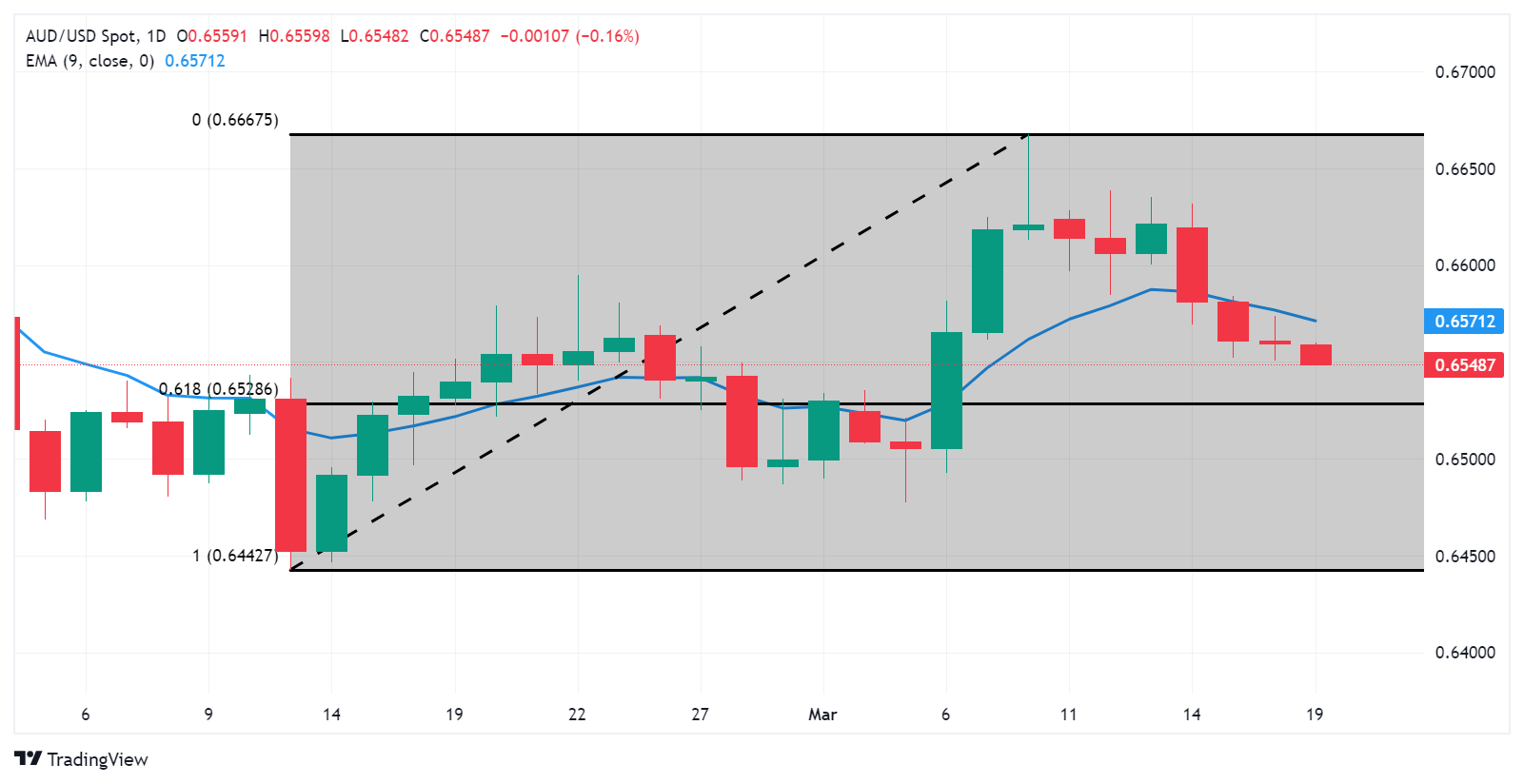- Australian Dollar depreciates on RBA’s decision to keep policy rates unchanged.
- Australian S&P/ASX 200 Index experiences thin trading activity due to market caution.
- US Dollar strengthens as US Treasury yields improve, fueled by expectations of the Fed being hawkish for an extended period.
The Australian Dollar (AUD) remained tepid amid subdued trading activity as market participants exercised caution ahead of the Reserve Bank of Australia’s (RBA) interest rate decision. However, the Aussie central bank kept its interest rate at 4.35% in March’s policy meeting. RBA Governor Michele Bullock addressed the policy outlook during a press conference following the monetary policy decision on Tuesday. She noted progress in the fight against inflation, citing recent data indicating the country is on the right track. However, she emphasized the importance of closely monitoring employment numbers. Governor Bullock highlighted that risks to the outlook are finely balanced and cautioned that the battle against inflation is not yet won.
The Australian equity market, the benchmark S&P/ASX 200 Index, has edged higher after starting the session positively, driven by gains in the energy and real estate sectors. This upward movement in the stock market may provide support for the Australian Dollar (AUD). Australia’s economy expanded less than anticipated in the fourth quarter of 2023, leading to speculation that the Reserve Bank of Australia could initiate rate cuts later this year.
The US Dollar Index (DXY) strives to extend its gains for the fourth consecutive session, bolstered by an uptick in US Treasury yields. Bond markets have experienced a sell-off following additional evidence of resilience in the United States (US) economy, compelling traders to adjust their expectations for fewer interest rate cuts this year. Investors are eagerly awaiting interest rate decisions from both the People’s Bank of China (PBoC) and the US Federal Reserve (Fed), which are anticipated to be announced on Wednesday.
Daily Digest Market Movers: Australian Dollar remains tepid on market caution
- The ANZ-Roy Morgan Australian Consumer Confidence index, which is published weekly, stands at 81.7, compared to the previous week’s reading of 82.2.
- According to Bloomberg, Westpac anticipates the Reserve Bank of Australia could maintain its cash rate at 4.35% at Tuesday’s meeting.
- ANZ Bank analysts anticipate that the Reserve Bank of Australia (RBA) will maintain a “mild tightening bias,” with no adjustment to interest rates.
- China’s Retail Sales (YoY) increased by 5.5% in February, against the expected 5.2% and 7.4% prior.
- Chinese Industrial Production (YoY) rose by 7.0%, compared to the market expectation of a 5.0% figure in February and 6.8% previous reading.
- According to the CME FedWatch Tool, the probability of a rate cut in March stands at 1.0% and 8.7% for May. The likelihood of a rate cut in June and July is lower, at 55.1% and 73.7%, respectively.
- The preliminary US Michigan Consumer Sentiment Index for March decreased to 76.5, from the previous reading of 76.9. This decline comes in contrast to expectations of it remaining unchanged.
- The Board of Governors of the Federal Reserve released Industrial Production (MoM), which increased by 0.1% in February, against the expected reading of flat 0.0% and from the previous decline of 0.5%.
- The US Core Producer Price Index (PPI) remained consistent with the rise of 2.0% year-over-year in February, maintaining its position above the 1.9% expected. The monthly report showed an increase of 0.3% against 0.5% prior, exceeding the expected 0.2% reading.
- US PPI (YoY) increased by 1.6% in February, surpassing the expected 1.1% and 1.0% prior. PPI (MoM) rose by 0.6% above the market expectation and the previous increase of 0.3%.
Technical Analysis: Australian Dollar maintains position near the major level at 0.6550
The Australian Dollar remains close to the significant threshold of 0.6550 on Tuesday. A breach below this level might prompt downward momentum for the AUD/USD pair, with additional support anticipated around the 61.8% Fibonacci retracement level of 0.6528, and thereafter at the psychological support level of 0.6500. On the upside, the AUD/USD pair could encounter resistance near the nine-day Exponential Moving Average (EMA) at 0.6571, followed by the psychological hurdle at 0.6600.
AUD/USD: Daily Chart
Australian Dollar price today
The table below shows the percentage change of Australian Dollar (AUD) against listed major currencies today. Australian Dollar was the weakest against the US Dollar.
| USD | EUR | GBP | CAD | AUD | JPY | NZD | CHF | |
| USD | 0.03% | 0.08% | 0.11% | 0.41% | 0.57% | 0.29% | 0.08% | |
| EUR | -0.03% | 0.05% | 0.07% | 0.36% | 0.53% | 0.26% | 0.06% | |
| GBP | -0.07% | -0.04% | 0.04% | 0.34% | 0.50% | 0.21% | 0.01% | |
| CAD | -0.11% | -0.07% | -0.01% | 0.27% | 0.47% | 0.19% | -0.02% | |
| AUD | -0.41% | -0.36% | -0.32% | -0.28% | 0.19% | -0.10% | -0.31% | |
| JPY | -0.59% | -0.52% | -0.50% | -0.45% | -0.15% | -0.25% | -0.47% | |
| NZD | -0.29% | -0.26% | -0.22% | -0.18% | 0.12% | 0.29% | -0.21% | |
| CHF | -0.09% | -0.06% | -0.01% | 0.02% | 0.32% | 0.49% | 0.20% |
The heat map shows percentage changes of major currencies against each other. The base currency is picked from the left column, while the quote currency is picked from the top row. For example, if you pick the Euro from the left column and move along the horizontal line to the Japanese Yen, the percentage change displayed in the box will represent EUR (base)/JPY (quote).
Australian Dollar FAQs
One of the most significant factors for the Australian Dollar (AUD) is the level of interest rates set by the Reserve Bank of Australia (RBA). Because Australia is a resource-rich country another key driver is the price of its biggest export, Iron Ore. The health of the Chinese economy, its largest trading partner, is a factor, as well as inflation in Australia, its growth rate, and Trade Balance. Market sentiment – whether investors are taking on more risky assets (risk-on) or seeking safe havens (risk-off) – is also a factor, with risk-on positive for AUD.
The Reserve Bank of Australia (RBA) influences the Australian Dollar (AUD) by setting the level of interest rates that Australian banks can lend to each other. This influences the level of interest rates in the economy as a whole. The main goal of the RBA is to maintain a stable inflation rate of 2-3% by adjusting interest rates up or down. Relatively high interest rates compared to other major central banks support the AUD, and the opposite for relatively low. The RBA can also use quantitative easing and tightening to influence credit conditions, with the former AUD-negative and the latter AUD-positive.
China is Australia’s largest trading partner so the health of the Chinese economy is a major influence on the value of the Australian Dollar (AUD). When the Chinese economy is doing well it purchases more raw materials, goods and services from Australia, lifting demand for the AUD, and pushing up its value. The opposite is the case when the Chinese economy is not growing as fast as expected. Positive or negative surprises in Chinese growth data, therefore, often have a direct impact on the Australian Dollar and its pairs.
Iron Ore is Australia’s largest export, accounting for $118 billion a year according to data from 2021, with China as its primary destination. The price of Iron Ore, therefore, can be a driver of the Australian Dollar. Generally, if the price of Iron Ore rises, AUD also goes up, as aggregate demand for the currency increases. The opposite is the case if the price of Iron Ore falls. Higher Iron Ore prices also tend to result in a greater likelihood of a positive Trade Balance for Australia, which is also positive of the AUD.
The Trade Balance, which is the difference between what a country earns from its exports versus what it pays for its imports, is another factor that can influence the value of the Australian Dollar. If Australia produces highly sought after exports, then its currency will gain in value purely from the surplus demand created from foreign buyers seeking to purchase its exports versus what it spends to purchase imports. Therefore, a positive net Trade Balance strengthens the AUD, with the opposite effect if the Trade Balance is negative.
Information on these pages contains forward-looking statements that involve risks and uncertainties. Markets and instruments profiled on this page are for informational purposes only and should not in any way come across as a recommendation to buy or sell in these assets. You should do your own thorough research before making any investment decisions. FXStreet does not in any way guarantee that this information is free from mistakes, errors, or material misstatements. It also does not guarantee that this information is of a timely nature. Investing in Open Markets involves a great deal of risk, including the loss of all or a portion of your investment, as well as emotional distress. All risks, losses and costs associated with investing, including total loss of principal, are your responsibility. The views and opinions expressed in this article are those of the authors and do not necessarily reflect the official policy or position of FXStreet nor its advertisers. The author will not be held responsible for information that is found at the end of links posted on this page.
If not otherwise explicitly mentioned in the body of the article, at the time of writing, the author has no position in any stock mentioned in this article and no business relationship with any company mentioned. The author has not received compensation for writing this article, other than from FXStreet.
FXStreet and the author do not provide personalized recommendations. The author makes no representations as to the accuracy, completeness, or suitability of this information. FXStreet and the author will not be liable for any errors, omissions or any losses, injuries or damages arising from this information and its display or use. Errors and omissions excepted.
The author and FXStreet are not registered investment advisors and nothing in this article is intended to be investment advice.
Editors’ Picks
USD/JPY holds steady in a familiar range above 151.00 mark
USD/JPY remains confined in a familiar range held over the past two weeks or so and trades with a mild positive bias above the 151.00 mark during the Asian session on Monday. The Bank of Japan’s uncertain outlook for future rate hikes, along with the risk-on mood, undermines the JPY and acts as a tailwind for the pair.
Note: This article have been indexed to our site. We do not claim legitimacy, ownership or copyright of any of the content above. To see the article at original source Click Here














